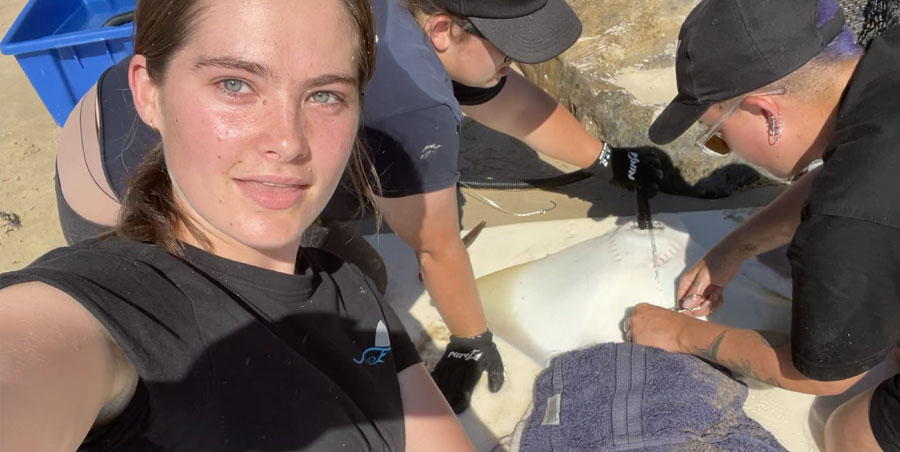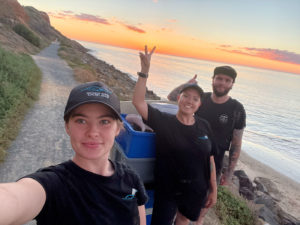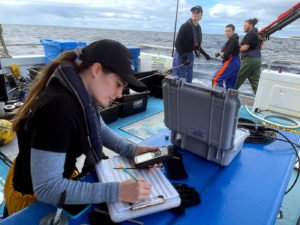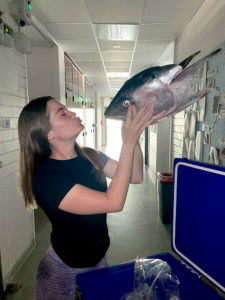
It was a chance to study with a bizarre creature of the deep and work with some of the best minds in her field that led Taryn-Lee Perrior to Flinders University and more adventure than she could have imagined.
Taryn (as her friends call her) is studying a bachelor of science (honours) (marine science) and looks back at the reason she landed in Adelaide. “Prof Charlie Huveneers and Dr Lauren Meyer (leaders of the Southern Shark Ecology Group) replied and offered me an opportunity of studying this amazingly bizarre creature called an elephant fish (Callorhinchus milii), a chimaera species which is closely related to sharks, skates, and rays.

“(It has) A nose like an elephant, a body like a shark, wings like a ray they use to fly like birds underwater, and a huge sharp barb on its dorsal fin. Like an ocean themed griffin (a mythical creature). I had never seen anything like it, and it sparked a curiosity in me like never before.”
While her fascination with the elephant fish sparked her passion, it was working with some of Flinders’ best that sealed the deal. “Having the opportunity to be mentored by Prof Charlie Huveneers, and Dr Lauren Meyer contributed to the decision to move, as working alongside leading researchers in this field was an opportunity I couldn’t turn down.”

There’s still much to learn about elephant fish, something Taryn is happy to take a leading role in. “Chimaeras receive very little research attention and there is so much we don’t know about them. My Honours project aims to describe and compare the feeding ecology of elephant fish (Callorhinchus milii) amongst South Australia, Victoria, and New Zealand. To do this, I have applied a multi-method approach including stomach content analysis, where I dissect the stomachs and identify prey items visually. I am also using biochemical tracers, i.e., stable isotopes (carbon and nitrogen) and fatty acids (like omega 3), that are incorporated in tissues to explore recent feeding ecology such as diet, habitat use, and ontogenetic or spatial-temporal shifts. This has involved a tremendous amount of lab work, where I am either working with a lot of chemicals or getting stinky from dissecting fish.”
Assisted in a local deployment of a receiver so that @Meyer_Sci can teach the marine ecology students from @Flinders about telemetry. What a great activity! @JDennis_Sci @Maddie95_ @HuveneersSSEG @FlindersSTEM pic.twitter.com/ufFPW8mDb4
— TarynPerrior (@Taryn_Perrior) September 30, 2021
Not only does Taryn’s research fire her passion, she also gets a taste of adventure helping other research projects being undertaken by the Flinders marine science team. “I am lucky enough to work in a lab that is very involved with one another’s projects. Whenever other Honours or PhD students have field work, I am often invited to assist. Not only is this extremely fun, but it is also helping develop my skill set and build a network within multiple fields.

While it’s tough to pick a field trip favourite, Taryn’s experiences researching white sharks near the Neptune Islands near Port Lincoln triggers fond memories. “These research expeditions are action-packed as we always work on multiple projects simultaneously, and use a range of tools and devices such as acoustic tags, accelerometers, feeding pills, biopsies, microbiome swabs, underwater videos, and wave buoys. These are not only to research the white sharks, but also the resident fish communities and surrounding environment. It is very up close and personal with nature and it was the first time I saw a white shark.
“I think every moment interacting with white sharks is exhilarating and I don’t think I’ll ever not feel the adrenaline around them. I am 5’1 ft so even a smaller great white is a monster fish next to me. We work off a marlin board at the back of the boat and there have been many times the team is trying to get a biopsy sample or swab, and a shark will come that close that the flick of its tail drenches us all in sea water.
I have finished dissecting all of my Australian ghostsharks (Callorhinchus milii) from South Australia and Victoria. Muscle, liver and the stomach was taken so that stable isotope analysis, fatty acid analysis and stomach content analysis can be performed. @SouthernSharkEG pic.twitter.com/Q9VuQ9H48z
— TarynPerrior (@Taryn_Perrior) August 8, 2021
Taryn also uses video and photography as another tool capture her work. “Firstly, as a scientist I wanted to document everything so if I needed to go back and check anything, I had it available. Then one day in the lab, I decided to make a video of me dissecting my elephant fish to show my friends and family back home, as I wanted to show them what I do, and I thought it was kind of funny how slimy I can get. Most of the people back home have no idea what marine science involves so I think videos and photos are a great way of capturing adventures and sharing it.”

Not only does it help her research, posting her images and videos on social platforms has proved a good way to network with fellow scientists. It’s also captured the imagination of her friends and family. “They think it’s wild! I get friends messaging me saying ‘I had no idea that’s what your work involved’. I love that I get to show everyone what I do and share the current research that is taking place. When they see the white shark videos, they think it’s wild that I get to be so close to them. Theses videos have started so many conversations with friends and family.”

So, Taryn, any advice for anyone wanting to follow a similar study path. “It’s such a fulfilling career path. Volunteering is a great way to build up your skills, helps you figure out what area of marine science you want to take (because there are so many avenues), and will really help your confidence and employability in the future. Networking is a great way to immerse yourself in the science, meet inspiring people, and create opportunities for yourself. Do your research, find people that inspire you and try and get them to mentor you. Having people more experienced close to you to learn from and inspire you will really help you for the future.”
Follow Taryn on:

